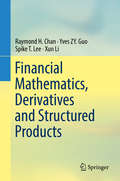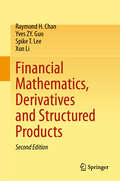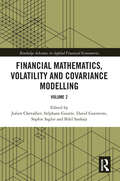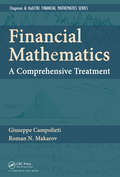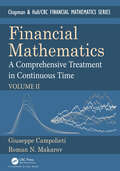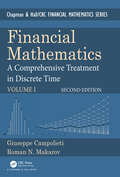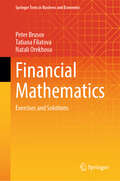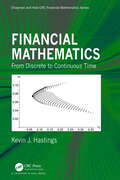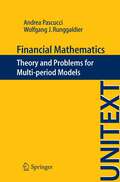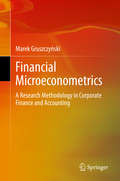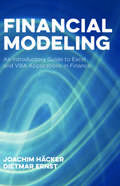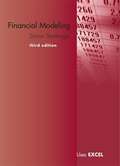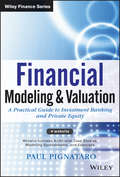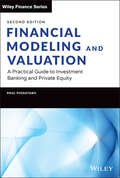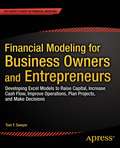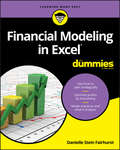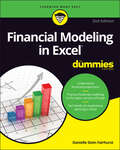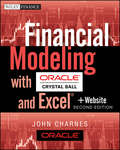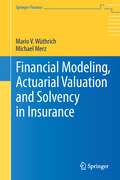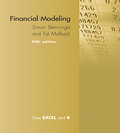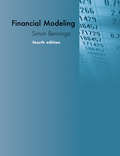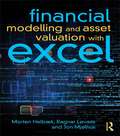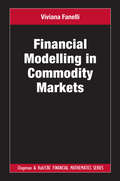- Table View
- List View
Financial Mathematics, Derivatives and Structured Products
by Raymond H. Chan Spike T. Lee Xun Li Yves ZY. GuoThis book introduces readers to the financial markets, derivatives, structured products and how the products are modelled and implemented by practitioners. In addition, it equips readers with the necessary knowledge of financial markets needed in order to work as product structurers, traders, sales or risk managers. As the book seeks to unify the derivatives modelling and the financial engineering practice in the market, it will be of interest to financial practitioners and academic researchers alike. Further, it takes a different route from the existing financial mathematics books, and will appeal to students and practitioners with or without a scientific background. The book can also be used as a textbook for the following courses: • Financial Mathematics (undergraduate level) • Stochastic Modelling in Finance (postgraduate level) • Financial Markets and Derivatives (undergraduate level) • Structured Products and Solutions (undergraduate/postgraduate level)
Financial Mathematics, Derivatives and Structured Products
by Raymond H. Chan Spike T. Lee Xun Li Yves ZY. GuoThis book introduces readers to the financial markets, derivatives, structured products and how the products are modelled and implemented by practitioners. In addition, it equips readers with the necessary knowledge of financial markets needed in order to work as product structurers, traders, sales or risk managers.This second edition substantially extends, updates and clarifies the previous edition. New materials and enhanced contents include, but not limited to, the role of central counterparties for derivatives transactions, the reference rates to replace LIBOR, risk-neutral modelling for futures and forward, discussions and analysis on risk-neutral framework and numéraires, discrete dividend modelling, variance reduction techniques for Monte Carlo method, finite difference method analysis, tree method, FX modelling, multi-name credit derivatives modelling, local volatility model, forward variance model and local-stochastic volatility model to reflect market practice.As the book seeks to unify the derivatives modelling and the financial engineering practice in the market, it will be of interest to financial practitioners and academic researchers alike. The book can also be used as a textbook for the following courses:• Financial Mathematics (undergraduate level)• Stochastic Modelling in Finance (postgraduate level)• Financial Markets and Derivatives (undergraduate level)• Structured Products and Solutions (undergraduate/postgraduate level)
Financial Mathematics, Volatility and Covariance Modelling: Volume 2 (Routledge Advances in Applied Financial Econometrics)
by Julien Chevallier Stéphane Goutte David Guerreiro Sophie Saglio Bilel SanhajiThis book provides an up-to-date series of advanced chapters on applied financial econometric techniques pertaining the various fields of commodities finance, mathematics & stochastics, international macroeconomics and financial econometrics. Financial Mathematics, Volatility and Covariance Modelling: Volume 2 provides a key repository on the current state of knowledge, the latest debates and recent literature on financial mathematics, volatility and covariance modelling. The first section is devoted to mathematical finance, stochastic modelling and control optimization. Chapters explore the recent financial crisis, the increase of uncertainty and volatility, and propose an alternative approach to deal with these issues. The second section covers financial volatility and covariance modelling and explores proposals for dealing with recent developments in financial econometrics This book will be useful to students and researchers in applied econometrics; academics and students seeking convenient access to an unfamiliar area. It will also be of great interest established researchers seeking a single repository on the current state of knowledge, current debates and relevant literature.
Financial Mathematics: A Comprehensive Treatment (Textbooks in Mathematics)
by Roman N. Makarov Giuseppe CampolietiVersatile for Several Interrelated Courses at the Undergraduate and Graduate Levels <P><P> Financial Mathematics: A Comprehensive Treatment provides a unified, self-contained account of the main theory and application of methods behind modern-day financial mathematics. Tested and refined through years of the authors’ teaching experiences, the book encompasses a breadth of topics, from introductory to more advanced ones. <P><P> Accessible to undergraduate students in mathematics, finance, actuarial science, economics, and related quantitative areas, much of the text covers essential material for core curriculum courses on financial mathematics. Some of the more advanced topics, such as formal derivative pricing theory, stochastic calculus, Monte Carlo simulation, and numerical methods, can be used in courses at the graduate level. Researchers and practitioners in quantitative finance will also benefit from the combination of analytical and numerical methods for solving various derivative pricing problems. <P><P> With an abundance of examples, problems, and fully worked out solutions, the text introduces the financial theory and relevant mathematical methods in a mathematically rigorous yet engaging way. Unlike similar texts in the field, this one presents multiple problem-solving approaches, linking related comprehensive techniques for pricing different types of financial derivatives. The book provides complete coverage of both discrete- and continuous-time financial models that form the cornerstones of financial derivative pricing theory. It also presents a self-contained introduction to stochastic calculus and martingale theory, which are key fundamental elements in quantitative finance.
Financial Mathematics: A Comprehensive Treatment in Continuous Time Volume II (Textbooks in Mathematics)
by Roman N. Makarov Giuseppe CampolietiThe book has been tested and refined through years of classroom teaching experience. With an abundance of examples, problems, and fully worked out solutions, the text introduces the financial theory and relevant mathematical methods in a mathematically rigorous yet engaging way. This textbook provides complete coverage of continuous-time financial models that form the cornerstones of financial derivative pricing theory. Unlike similar texts in the field, this one presents multiple problem-solving approaches, linking related comprehensive techniques for pricing different types of financial derivatives. Key features: In-depth coverage of continuous-time theory and methodology Numerous, fully worked out examples and exercises in every chapter Mathematically rigorous and consistent, yet bridging various basic and more advanced concepts Judicious balance of financial theory and mathematical methods Guide to Material This revision contains: Almost 150 pages worth of new material in all chapters A appendix on probability theory An expanded set of solved problems and additional exercises Answers to all exercises This book is a comprehensive, self-contained, and unified treatment of the main theory and application of mathematical methods behind modern-day financial mathematics. The text complements Financial Mathematics: A Comprehensive Treatment in Discrete Time, by the same authors, also published by CRC Press.
Financial Mathematics: A Comprehensive Treatment in Discrete Time (Chapman and Hall/CRC Financial Mathematics Series)
by Roman N. Makarov Giuseppe CampolietiThe book has been tested and refined through years of classroom teaching experience. With an abundance of examples, problems, and fully worked out solutions, the text introduces the financial theory and relevant mathematical methods in a mathematically rigorous yet engaging way. This textbook provides complete coverage of discrete-time financial models that form the cornerstones of financial derivative pricing theory. Unlike similar texts in the field, this one presents multiple problem-solving approaches, linking related comprehensive techniques for pricing different types of financial derivatives. Key features: In-depth coverage of discrete-time theory and methodology. Numerous, fully worked out examples and exercises in every chapter. Mathematically rigorous and consistent yet bridging various basic and more advanced concepts. Judicious balance of financial theory, mathematical, and computational methods. Guide to Material. This revision contains: Almost 200 pages worth of new material in all chapters. A new chapter on elementary probability theory. An expanded the set of solved problems and additional exercises. Answers to all exercises. This book is a comprehensive, self-contained, and unified treatment of the main theory and application of mathematical methods behind modern-day financial mathematics. Table of Contents List of Figures and Tables Preface I Introduction to Pricing and Management of Financial Securities 1 Mathematics of Compounding2 Primer on Pricing Risky Securities 3 Portfolio Management 4 Primer on Derivative Securities II Discrete-Time Modelling 5 Single-Period Arrow–Debreu Models 6 Introduction to Discrete-Time Stochastic Calculus 7 Replication and Pricing in the Binomial Tree Model 8 General Multi-Asset Multi-Period Model Appendices A Elementary Probability Theory B Glossary of Symbols and Abbreviations C Answers and Hints to Exercises References Index Biographies Giuseppe Campolieti is Professor of Mathematics at Wilfrid Laurier University in Waterloo, Canada. He has been Natural Sciences and Engineering Research Council postdoctoral research fellow and university research fellow at the University of Toronto. In 1998, he joined the Masters in Mathematical Finance as an instructor and later as an adjunct professor in financial mathematics until 2002. Dr. Campolieti also founded a financial software and consulting company in 1998. He joined Laurier in 2002 as Associate Professor of Mathematics and as SHARCNET Chair in Financial Mathematics. Roman N. Makarov is Associate Professor and Chair of Mathematics at Wilfrid Laurier University. Prior to joining Laurier in 2003, he was an Assistant Professor of Mathematics at Siberian State University of Telecommunications and Informatics and a senior research fellow at the Laboratory of Monte Carlo Methods at the Institute of Computational Mathematics and Mathematical Geophysics in Novosibirsk, Russia.
Financial Mathematics: Exercises and Solutions (Springer Texts in Business and Economics)
by Peter Brusov Tatiana Filatova Natali OrekhovaThis textbook is designed to facilitate a thorough learning for students of financial mathematics. It includes exercises and theoretical questions across seven chapters: Interest Theory, Financial Flows and Annuities, Profitability and Risk of Financial Operations, Portfolio Analysis, Bonds, Modigliani-Miller Theory, and Brusov-Filatova-Orekhova Theory. The last two chapters are dedicated to modern theories of capital structure, including problems and tasks. More than 130 detailed solutions are provided to help students solve the assignments in the textbook. This textbook is suitable for undergraduate and graduate students in all financial and economic fields, including finance and credit, accounting and auditing, taxes, insurance, and international economic relations. It is also useful for professionals in financial and economic specialties, including financial analysts, as well as anyone interested in mastering quantitative methods in finance and economics.
Financial Mathematics: From Discrete to Continuous Time (Chapman and Hall/CRC Financial Mathematics Series)
by Kevin J. HastingsFinancial Mathematics: From Discrete to Continuous Time is a study of the mathematical ideas and techniques that are important to the two main arms of the area of financial mathematics: portfolio optimization and derivative valuation. The text is authored for courses taken by advanced undergraduates, MBA, or other students in quantitative finance programs. The approach will be mathematically correct but informal, sometimes omitting proofs of the more difficult results and stressing practical results and interpretation. The text will not be dependent on any particular technology, but it will be laced with examples requiring the numerical and graphical power of the machine. The text illustrates simulation techniques to stand in for analytical techniques when the latter are impractical. There will be an electronic version of the text that integrates Mathematica functionality into the development, making full use of the computational and simulation tools that this program provides. Prerequisites are good courses in mathematical probability, acquaintance with statistical estimation, and a grounding in matrix algebra. The highlights of the text are: A thorough presentation of the problem of portfolio optimization, leading in a natural way to the Capital Market Theory Dynamic programming and the optimal portfolio selection-consumption problem through time An intuitive approach to Brownian motion and stochastic integral models for continuous time problems The Black-Scholes equation for simple European option values, derived in several different ways A chapter on several types of exotic options Material on the management of risk in several contexts
Financial Mathematics: Theory and Problems for Multi-period Models
by Wolfgang J. Runggaldier Andrea PascucciWith the Bologna Accords a bachelor-master-doctor curriculum has been introduced in various countries with the intention that students may enter the job market already at the bachelor level. Since financial Institutions provide non negligible job opportunities also for mathematicians, and scientists in general, it appeared to be appropriate to have a financial mathematics course already at the bachelor level in mathematics. Most mathematical techniques in use in financial mathematics are related to continuous time models and require thus notions from stochastic analysis that bachelor students do in general not possess. Basic notions and methodologies in use in financial mathematics can however be transmitted to students also without the technicalities from stochastic analysis by using discrete time (multi-period) models for which general notions from Probability suffice and these are generally familiar to students not only from science courses, but also from economics with quantitative curricula. There do not exists many textbooks for multi-period models and the present volume is intended to fill in this gap. It deals with the basic topics in financial mathematics and, for each topic, there is a theoretical section and a problem section. The latter includes a great variety of possible problems with complete solution.
Financial Microeconometrics: A Research Methodology in Corporate Finance and Accounting
by Marek GruszczyńskiThis book explores new topics in modern research on empirical corporate finance and applied accounting, especially the econometric analysis of microdata. Dubbed “financial microeconometrics” by the author, this concept unites both methodological and applied approaches. The book examines how quantitative methods can be applied in corporate finance and accounting research in order to predict companies getting into financial distress. Presented in a clear and straightforward manner, it also suggests methods for linking corporate governance to financial performance, and discusses what the determinants of accounting disclosures are. Exploring these questions by way of numerous practical examples, this book is intended for researchers, practitioners and students who are not yet familiar with the variety of approaches available for data analysis and microeconometrics.“This book on financial microeconometrics is an excellent starting point for research in corporate finance and accounting. In my view, the text is positioned between a narrative and a scientific treatise. It is based on a vast amount of literature but is not overloaded with formulae. My appreciation of financial microeconometrics has very much increased. The book is well organized and properly written. I enjoyed reading it.” Wolfgang Marty, Senior Investment Strategist, AgaNola AG
Financial Missionaries to the World: The Politics and Culture of Dollar Diplomacy 1900-1930
by Emily S. RosenbergWinner of the Society for Historians of American Foreign Relations Robert H. Ferrell Book Prize Financial Missionaries to the World establishes the broad scope and significance of "dollar diplomacy"--the use of international lending and advising--to early-twentieth-century U. S. foreign policy. Combining diplomatic, economic, and cultural history, the distinguished historian Emily S. Rosenberg shows how private bank loans were extended to leverage the acceptance of American financial advisers by foreign governments. In an analysis striking in its relevance to contemporary debates over international loans, she reveals how a practice initially justified as a progressive means to extend "civilization" by promoting economic stability and progress became embroiled in controversy. Vocal critics at home and abroad charged that American loans and financial oversight constituted a new imperialism that fostered exploitation of less powerful nations. By the mid-1920s, Rosenberg explains, even early supporters of dollar diplomacy worried that by facilitating excessive borrowing, the practice might induce the very instability and default that it supposedly worked against. "[A] major and superb contribution to the history of U. S. foreign relations. . . . [Emily S. Rosenberg] has opened up a whole new research field in international history. "--Anders Stephanson, Journal of American History "[A] landmark in the historiography of American foreign relations. "--Melvyn P. Leffler, author of A Preponderence of Power: National Security, the Truman Administration, and the Cold War "Fascinating. "--Christopher Clark, Times Literary Supplement
Financial Modeling
by Joachim Häcker Dietmar ErnstNachvollziehbare Modelle zur Beurteilung komplexer Finanzprodukte. Die Autoren bieten Studenten einen anwendungsorientierten Leitfaden zu den zentralen Themenkomplexen Corporate Finance, Derivate und Portfoliomanagement. Zwei Workshops zu Microsoft Excel(r) und der Programmiersprache VBA(r) komplettieren das finanzwirtschaftliche Know-how. Der Kurscharakter des Buches und die praxisnahen Beispiele, die zusatzlich als Download-Angebot zur Verfugung stehen, ermoglichen ein schnelles und interaktives Lernen. Als Nachschlagewerk leistet der Band auch Praktikern wertvolle Dienste. "
Financial Modeling (3rd Edition)
by Simon BenningaToo often, finance courses stop short of making a connection between textbook finance and the problems of real-world business. Financial Modeling bridges this gap between theory and practice by providing a nuts-and-bolts guide to solving common financial models with spreadsheets. Simon Benninga takes the reader step by step through each model, showing how it can be solved using Microsoft Excel. The long-awaited third edition of this standard text maintains the "cookbook" features and Excel dependence that have made the first and second editions so popular. It also offers significant new material, with new chapters covering such topics as bank valuation, the Black-Litterman approach to portfolio optimization, Monte Carlo methods and their applications to option pricing, and using array functions and formulas. Other chapters, including those on basic financial calculations, portfolio models, calculating the variance-covariance matrix,and generating random numbers, have been revised, with many offering substantially new and improved material. Other areas covered include financial statement modeling, leasing, standard portfolio problems, value at risk (VaR), real options, duration and immunization, and term structure modeling. Technical chapters treat such topics as data tables, matrices, the Gauss-Seidel method, and tips for using Excel. The last section of the text covers the Visual Basic for Applications (VBA) techniques needed for the book. The accompanying CD contains Excel worksheets and solutions to end-of-chapter exercises.
Financial Modeling and Valuation
by Paul PignataroWritten by the Founder and CEO of the prestigious New York School of Finance, this book schools you in the fundamental tools for accurately assessing the soundness of a stock investment. Built around a full-length case study of Wal-Mart, it shows you how to perform an in-depth analysis of that company's financial standing, walking you through all the steps of developing a sophisticated financial model as done by professional Wall Street analysts. You will construct a full scale financial model and valuation step-by-step as you page through the book.When we ran this analysis in January of 2012, we estimated the stock was undervalued. Since the first run of the analysis, the stock has increased 35 percent. Re-evaluating Wal-Mart 9months later, we will step through the techniques utilized by Wall Street analysts to build models on and properly value business entities.Step-by-step financial modeling - taught using downloadable Wall Street models, you will construct the model step by step as you page through the book.Hot keys and explicit Excel instructions aid even the novice excel modeler.Model built complete with Income Statement, Cash Flow Statement, Balance Sheet, Balance Sheet Balancing Techniques, Depreciation Schedule (complete with accelerating depreciation and deferring taxes), working capital schedule, debt schedule, handling circular references, and automatic debt pay downs.Illustrative concepts including detailing model flows help aid in conceptual understanding.Concepts are reiterated and honed, perfect for a novice yet detailed enough for a professional.Model built direct from Wal-Mart public filings, searching through notes, performing research, and illustrating techniques to formulate projections.Includes in-depth coverage of valuation techniques commonly used by Wall Street professionals.Illustrative comparable company analyses - built the right way, direct from historical financials, calculating LTM (Last Twelve Month) data, calendarization, and properly smoothing EBITDA and Net Income.Precedent transactions analysis - detailing how to extract proper metrics from relevant proxy statementsDiscounted cash flow analysis - simplifying and illustrating how a DCF is utilized, how unlevered free cash flow is derived, and the meaning of weighted average cost of capital (WACC)Step-by-step we will come up with a valuation on Wal-MartChapter end questions, practice models, additional case studies and common interview questions (found in the companion website) help solidify the techniques honed in the book; ideal for universities or business students looking to break into the investment banking field.
Financial Modeling and Valuation: A Practical Guide to Investment Banking and Private Equity (Wiley Finance)
by Paul PignataroThe fully revised new edition of the best-selling guide to using financial models to determine if a stock is over or undervalued Written by the founder and CEO of the world-renowned New York School of Finance, Financial Modeling and Valuation provides clear and systematic guidance on accurately evaluating the soundness of a stock investment. This invaluable handbook equips investors with the tools necessary for understanding the underlying fundamentals of a rational investment and for making smarter investment decisions in any market environment. Built around an in-depth case study of global retail leader Amazon, this fully updated Second Edition shows you how to analyze the financial standing of a company using the methods of Wall Street professionals. Step-by-step, you will learn to build the core three statements—income statement, cash flow statement, and balance sheet—as well as the three major supporting schedules required for complete company valuation and analysis. All line items are explained in clear language and include real-world tips and techniques for using them as tools for valuing and managing a business. This must-have guide: Features new and in-depth case studies based on Amazon that simulate real-world modelling and valuation Explains valuation techniques such as illustrative comparable company analysis, precedent transactions analysis, and discounted cash flow analysis Covers all essential applications of a model, including pricing a stock, raising debt, and raising equity Includes an introductory section describing the recent and dramatic shift of the entire retail industry Provides end-of-chapter questions, downloadable practice models, additional case studies, and common interview questions via a companion website Financial Modeling and Valuation: A Practical Guide to Investment Banking and Private Equity, Second Edition is essential reading for finance professionals, venture capitalists, individual investors, and students in investment banking and related degree programs in finance.
Financial Modeling for Business Owners and Entrepreneurs
by Tom Y. SawyerFinancial Modeling for Business Owners and Entrepreneurs: Developing Excel Models to Raise Capital, Increase Cash Flow, Improve Operations, Plan Projects, and Make Decisions may be one of the most important books any entrepreneur or manager in a small or medium-sized enterprise will read. It combines logical business principles and strategies with a step-by-step methodology for planning and modeling a company and solving specific business problems. You'll learn to create operational and financial models in Excel that describe the workings of your company in quantitative terms and that make it far more likely you will avoid the traps and dead ends many businesses fall into. Serial entrepreneur and financial expert Tom Y. Sawyer shows how to break your company down into basic functional and operational components that can be modeled. The result is a financial model that, for example, you can literally take to the bank or bring to local angel investors to receive the funding you need to launch your business or a new product. Or it might be a model that shows with startling clarity that your new product development effort is a likely winner--or loser. Even better, you'll learn to create models that will serve as guideposts for ongoing operations. You'll always know just where you are financially, and where you need to be. The models you will learn to build in Financial Modeling for Business Owners and Entrepreneurs can be used to: Raise capital for startup or any stage of growthPlan projects and new initiativesMake astute business decisions, including go/no-go assessmentsAnalyze ROI on your product development and marketing expendituresStreamline operations, manage budgets, improve efficiency, and reduce costsValue the business when it is time to cash out or mergeIn addition to many valuable exercises and tips for using Excel to model your business, this book contains a combination of practical advice born of hard-won lessons, advanced strategic thought, and the insightful use of hard skills. With a basic knowledge of Excel assumed, it will help you learn to think like an experienced business person who expects to make money on the products or services offered to the public. You'll discover that the financial model is a key management tool that, if built correctly, provides invaluable assistance every step of the entrepreneurial journey. Tom Y. Sawyer has used the principles this book contains to create financial models of numerous startup and early-stage companies, assisting them in planning for and raising the capital that they needed to grow their businesses and ultimately exit with multiples of their initial investment. Financial Modeling for Business Owners and Entrepreneurs, a mini-MBA in entrepreneurship and finance, will show you how you can do the same. Note: This book is an updated version of Sawyer's 2009 title, Pro Excel Financial Modeling.
Financial Modeling in Excel For Dummies
by Danielle Stein FairhurstMake informed business decisions with the beginner's guide to financial modeling using Microsoft Excel Financial Modeling in Excel For Dummies is your comprehensive guide to learning how to create informative, enlightening financial models today. Not a math whiz or an Excel power-user? No problem! All you need is a basic understanding of Excel to start building simple models with practical hands-on exercises. Before you know it, you’ll be modeling your way to optimized profits for your business in no time. Excel is powerful, user-friendly, and is most likely already installed on your computer—which is why it has so readily become the most popular financial modeling software. This book shows you how to harness Excel's capabilities to determine profitability, develop budgetary projections, model depreciation, project costs, value assets, and more. You'll learn the fundamental best practices and know-how of financial modeling, and how to put them to work for your business and your clients. You'll learn the tools and techniques that bring insight out of the numbers and make better business decisions based on quantitative evidence. You'll discover that financial modeling is an invaluable resource for your business, and you'll wonder why you've waited this long to learn how! Companies around the world use financial modeling for decision making, to steer strategy, and to develop solutions. This book walks you through the process with clear, expert guidance that assumes little prior knowledge. Learn the six crucial rules to follow when building a successful financial model Discover how to review and edit an inherited financial model and align it with your business and financial strategy Solve client problems, identify market projections, and develop business strategies based on scenario analysis Create valuable customized templates models that can become a source of competitive advantage From multinational corporations to the mom-and-pop corner store, there isn't a business around that wouldn't benefit from financial modeling. No need to buy expensive specialized software—the tools you need are right there in Excel. Financial Modeling in Excel For Dummies gets you up to speed quickly so you can start reaping the benefits today!
Financial Modeling in Excel For Dummies
by Danielle Stein FairhurstTurn your financial data into insightful decisions with this straightforward guide to financial modeling with Excel Interested in learning how to build practical financial models and forecasts but concerned that you don’t have the math skills or technical know-how? We’ve got you covered! Financial decision-making has never been easier than with Financial Modeling in Excel For Dummies. Whether you work at a mom-and-pop retail store or a multinational corporation, you can learn how to build budgets, project your profits into the future, model capital depreciation, value your assets, and more. You’ll learn by doing as this book walks you through practical, hands-on exercises to help you build powerful models using just a regular version of Excel, which you’ve probably already got on your PC. You’ll also: Master the tools and strategies that help you draw insights from numbers and data you’ve already got Build a successful financial model from scratch, or work with and modify an existing one to your liking Create new and unexpected business strategies with the ideas and conclusions you generate with scenario analysis Don’t go buying specialized software or hiring that expensive consultant when you don’t need either one. If you’ve got this book and a working version of Microsoft Excel, you’ve got all the tools you need to build sophisticated and useful financial models in no time!
Financial Modeling with Crystal Ball and Excel
by John CharnesPraise forFinancial Modeling with Crystal Ball(r) and Excel(r)"Professor Charnes's book drives clarity into applied Monte Carlo analysis using examples and tools relevant to real-world finance. The book will prove useful for analysts of all levels and as a supplement to academic courses in multiple disciplines."-Mark Odermann, Senior Financial Analyst, Microsoft"Think you really know financial modeling? This is a must-have for power Excel users. Professor Charnes shows how to make more realistic models that result in fewer surprises. Every analyst needs this credibility booster."-James Franklin, CEO, Decisioneering, Inc."This book packs a first-year MBA's worth of financial and business modeling education into a few dozen easy-to-understand examples. Crystal Ball software does the housekeeping, so readers can concentrate on the business decision. A careful reader who works the examples on a computer will master the best general-purpose technology available for working with uncertainty."-Aaron Brown, Executive Director, Morgan Stanley, author of The Poker Face of Wall Street"Using Crystal Ball and Excel, John Charnes takes you step by step, demonstrating a conceptual framework that turns static Excel data and financial models into true risk models. I am astonished by the clarity of the text and the hands-on, step-by-step examples using Crystal Ball and Excel; Professor Charnes is a masterful teacher, and this is an absolute gem of a book for the new generation of analyst."-Brian Watt, Chief Operating Officer, GECC, Inc."Financial Modeling with Crystal Ball and Excel is a comprehensive, well-written guide to one of the most useful analysis tools available to professional risk managers and quantitative analysts. This is a must-have book for anyone using Crystal Ball, and anyone wanting an overview of basic risk management concepts."-Paul Dietz, Manager, Quantitative Analysis, Westar Energy"John Charnes presents an insightful exploration of techniques for analysis and understanding of risk and uncertainty in business cases. By application of real options theory and Monte Carlo simulation to planning, doors are opened to analysis of what used to be impossible, such as modeling the value today of future project choices."-Bruce Wallace, Nortel
Financial Modeling with Crystal Ball and Excel (Wiley Finance #341)
by John CharnesPraise for Financial Modeling with Crystal Ball(r) and Excel(r) "Professor Charnes's book drives clarity into applied Monte Carlo analysis using examples and tools relevant to real-world finance. The book will prove useful for analysts of all levels and as a supplement to academic courses in multiple disciplines." -Mark Odermann, Senior Financial Analyst, Microsoft "Think you really know financial modeling? This is a must-have for power Excel users. Professor Charnes shows how to make more realistic models that result in fewer surprises. Every analyst needs this credibility booster." -James Franklin, CEO, Decisioneering, Inc. "This book packs a first-year MBA's worth of financial and business modeling education into a few dozen easy-to-understand examples. Crystal Ball software does the housekeeping, so readers can concentrate on the business decision. A careful reader who works the examples on a computer will master the best general-purpose technology available for working with uncertainty." -Aaron Brown, Executive Director, Morgan Stanley, author of The Poker Face of Wall Street "Using Crystal Ball and Excel, John Charnes takes you step by step, demonstrating a conceptual framework that turns static Excel data and financial models into true risk models. I am astonished by the clarity of the text and the hands-on, step-by-step examples using Crystal Ball and Excel; Professor Charnes is a masterful teacher, and this is an absolute gem of a book for the new generation of analyst." -Brian Watt, Chief Operating Officer, GECC, Inc. "Financial Modeling with Crystal Ball and Excel is a comprehensive, well-written guide to one of the most useful analysis tools available to professional risk managers and quantitative analysts. This is a must-have book for anyone using Crystal Ball, and anyone wanting an overview of basic risk management concepts." -Paul Dietz, Manager, Quantitative Analysis, Westar Energy "John Charnes presents an insightful exploration of techniques for analysis and understanding of risk and uncertainty in business cases. By application of real options theory and Monte Carlo simulation to planning, doors are opened to analysis of what used to be impossible, such as modeling the value today of future project choices." -Bruce Wallace, Nortel
Financial Modeling, Actuarial Valuation and Solvency in Insurance
by Mario V. Wüthrich Michael MerzRisk management for financial institutions is one of the key topics the financial industry has to deal with. The present volume is a mathematically rigorous text on solvency modeling. Currently, there are many new developments in this area in the financial and insurance industry (Basel III and Solvency II), but none of these developments provides a fully consistent and comprehensive framework for the analysis of solvency questions. Merz and Wüthrich combine ideas from financial mathematics (no-arbitrage theory, equivalent martingale measure), actuarial sciences (insurance claims modeling, cash flow valuation) and economic theory (risk aversion, probability distortion) to provide a fully consistent framework. Within this framework they then study solvency questions in incomplete markets, analyze hedging risks, and study asset-and-liability management questions, as well as issues like the limited liability options, dividend to shareholder questions, the role of re-insurance, etc. This work embeds the solvency discussion (and long-term liabilities) into a scientific framework and is intended for researchers as well as practitioners in the financial and actuarial industry, especially those in charge of internal risk management systems. Readers should have a good background in probability theory and statistics, and should be familiar with popular distributions, stochastic processes, martingales, etc.
Financial Modeling, fifth edition
by Simon Benninga Tal MofkadiA substantially updated new edition of the essential text on financial modeling, with revised material, new data, and implementations shown in Excel, R, and Python.Financial Modeling has become the gold-standard text in its field, an essential guide for students, researchers, and practitioners that provides the computational tools needed for modeling finance fundamentals. This fifth edition has been substantially updated but maintains the straightforward, hands-on approach, with an optimal mix of explanation and implementation, that made the previous editions so popular. Using detailed Excel spreadsheets, it explains basic and advanced models in the areas of corporate finance, portfolio management, options, and bonds. This new edition offers revised material on valuation, second-order and third-order Greeks for options, value at risk (VaR), Monte Carlo methods, and implementation in R. The examples and implementation use up-to-date and relevant data. Parts I to V cover corporate finance topics, bond and yield curve models, portfolio theory, options and derivatives, and Monte Carlo methods and their implementation in finance. Parts VI and VII treat technical topics, with part VI covering Excel and R issues and part VII (now on the book&’s auxiliary website) covering Excel&’s programming language, Visual Basic for Applications (VBA), and Python implementations. Knowledge of technical chapters on VBA and R is not necessary for understanding the material in the first five parts. The book is suitable for use in advanced finance classes that emphasize the need to combine modeling skills with a deeper knowledge of the underlying financial models.
Financial Modeling, fourth edition (The\mit Press Ser.)
by Simon BenningaA substantially revised edition of a bestselling text combining explanation and implementation using Excel; for classroom use or as a reference for finance practitioners. Financial Modeling is now the standard text for explaining the implementation of financial models in Excel. This long-awaited fourth edition maintains the “cookbook” features and Excel dependence that have made the previous editions so popular. As in previous editions, basic and advanced models in the areas of corporate finance, portfolio management, options, and bonds are explained with detailed Excel spreadsheets. Sections on technical aspects of Excel and on the use of Visual Basic for Applications (VBA) round out the book to make Financial Modeling a complete guide for the financial modeler.The new edition of Financial Modeling includes a number of innovations. A new section explains the principles of Monte Carlo methods and their application to portfolio management and exotic option valuation. A new chapter discusses term structure modeling, with special emphasis on the Nelson-Siegel model. The discussion of corporate valuation using pro forma models has been rounded out with the introduction of a new, simple model for corporate valuation based on accounting data and a minimal number of valuation parameters.New print copies of this book include a card affixed to the inside back cover with a unique access code. Access codes are required to download Excel worksheets and solutions to end-of-chapter exercises. If you have a used copy of this book, you may purchase a digitally-delivered access code separately via the Supplemental Material link on this page. If you purchased an e-book, you may obtain a unique access code by emailing digitalproducts-cs@mit.edu or calling 617-253-2889 or 800-207-8354 (toll-free in the U.S. and Canada).Praise for earlier editions“Financial Modeling belongs on the desk of every finance professional. Its no-nonsense, hands-on approach makes it an indispensable tool.”—Hal R. Varian, Dean, School of Information Management and Systems, University of California, Berkeley“Financial Modeling is highly recommended to readers who are interested in an introduction to basic, traditional approaches to financial modeling and analysis, as well as to those who want to learn more about applying spreadsheet software to financial analysis."—Edward Weiss, Journal of Computational Intelligence in Finance“Benninga has a clear writing style and uses numerous illustrations, which make this book one of the best texts on using Excel for finance that I've seen.”—Ed McCarthy, Ticker Magazine
Financial Modelling and Asset Valuation with Excel
by Morten Helbæk Ragnar Løvaas Jon Olav MjølhusFinance is Excel! This book takes you straight into the fascinating world of Excel, the powerful tool for number crunching. In a clear cut language it amalgamates financial theory with Excel providing you with the skills you need to build financial models for private or professional use. A comprehensive knowledge of modeling in Excel is becoming increasingly important in a competitive labour market. The chapters in part one start with the most basic Excel topics such as cell addresses, workbooks, basic formulas, etc. These chapters get more advanced through part one, and takes you in the end to topics such as array formulas, data tables, pivot tables, etc. The other parts of the book discusses a variety of subjects such as net present value, internal rate of return, risk, portfolio theory, CAPM, VaR, project valuation, asset valuation, firm valuation, loan, leasing, stocks, bonds, options, simulation, sensitivity analysis, etc.
Financial Modelling in Commodity Markets (Chapman and Hall/CRC Financial Mathematics Series)
by Viviana FanelliFinancial Modelling in Commodity Markets provides a basic and self-contained introduction to the ideas underpinning financial modelling of products in commodity markets. The book offers a concise and operational vision of the main models used to represent, assess and simulate real assets and financial positions related to the commodity markets. It discusses statistical and mathematical tools important for estimating, implementing and calibrating quantitative models used for pricing and trading commodity-linked products and for managing basic and complex portfolio risks. Key features: Provides a step-by-step guide to the construction of pricing models, and for the applications of such models for the analysis of real data Written for scholars from a wide range of scientific fields, including economics and finance, mathematics, engineering and statistics, as well as for practitioners Illustrates some important pricing models using real data sets that will be commonly used in financial markets
